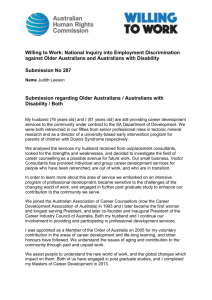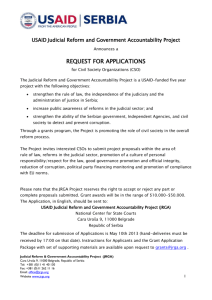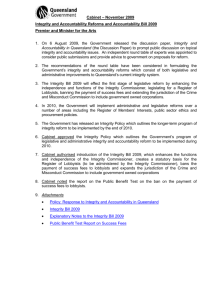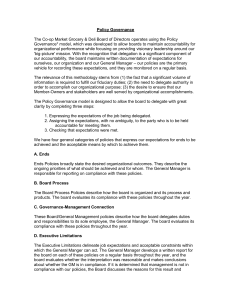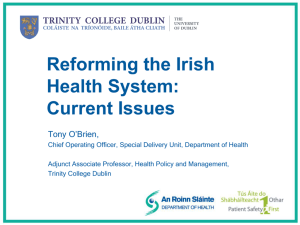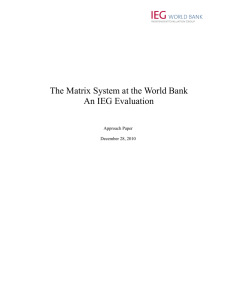Principles to shape Australia`s health system
advertisement
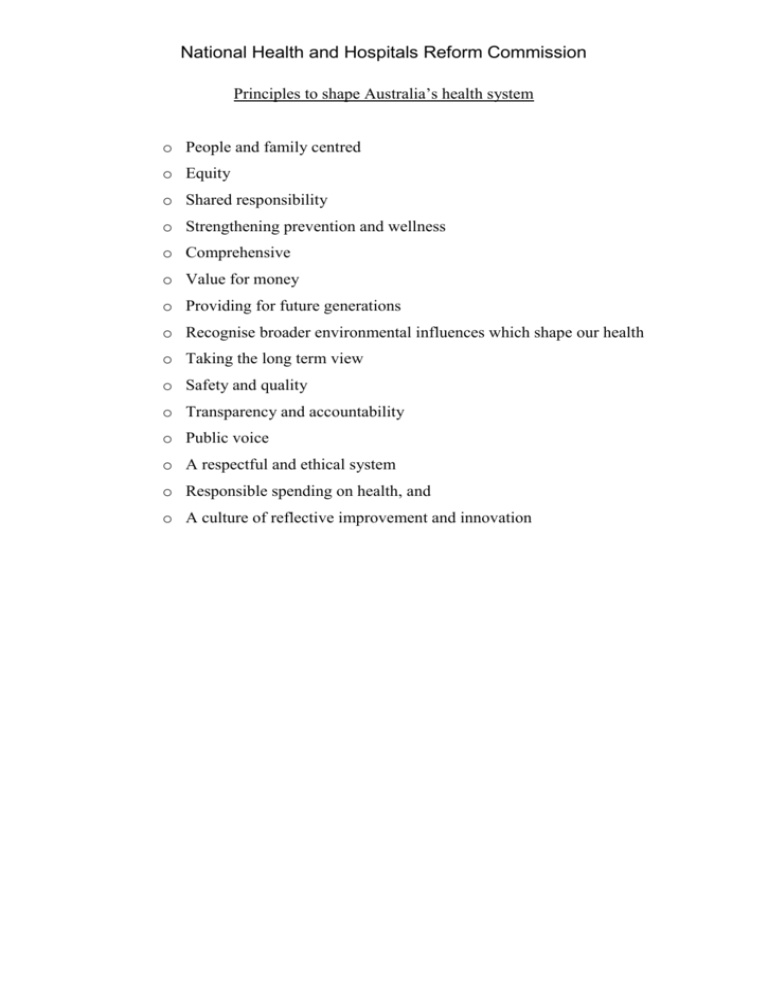
National Health and Hospitals Reform Commission Principles to shape Australia’s health system o People and family centred o Equity o Shared responsibility o Strengthening prevention and wellness o Comprehensive o Value for money o Providing for future generations o Recognise broader environmental influences which shape our health o Taking the long term view o Safety and quality o Transparency and accountability o Public voice o A respectful and ethical system o Responsible spending on health, and o A culture of reflective improvement and innovation National Health and Hospitals Reform Commission The Commission has developed a set of principles which to a large extent should shape the whole health and aged care system - public and private, hospital and community based services. Proposed design principles (generally what we as citizens and potential patients want from the system). 1. People and family centred: The direction of our health system and the provision of health services must be shaped around the health needs of individuals, their families and communities. The health system should be responsive to individual differences, cultural diversity and preferences through choice in health care. Pathways of care, currently often complex and confusing, should be easy to navigate and, where necessary, people should be given help to navigate the system including through reliable and evidence based information and advice to make appropriate choices. Care should be provided in the most favourable environment: closer to home if possible and with a preference for less ‘institutional’ settings and with an emphasis on supporting people to achieve their maximum health potential. 2. Equity: Health care in Australia should be accessible to all based on health needs not ability to pay. The multiple dimensions of inequality should be addressed, whether related to geographic location, socio-economic status, language, culture or indigenous status. A key underpinning for equity is the principle of universality as expressed in the design of Medicare, the Pharmaceutical Benefits Scheme and public hospital care. Addressing inequality in health access and outcomes requires action beyond these three programs, including through engagement with other policy sectors (such as the education system, and employment). The health system must recognise and respond to those with special needs (the marginalised or underprovided for groups in society). Special attention needs to be given to working with Aboriginal and Torres Strait Islander people to close the gap between indigenous health status and that of other Australians. 3. Shared responsibility: All Australians share responsibility for our health and the success of the health system. We each make choices about our life-style and personal risk behaviours, shaped by our physical and social circumstances, life opportunities and environment, which impact our health risks and outcomes. As a community we fund the health system. As consumers or patients we make decisions about how we will use the health system and work with the professionals who care for us. Health professionals have a responsibility to communicate clearly, to help us 1 National Health and Hospitals Reform Commission understand the choices available to us, and to empower us to take an active role in our treatment in a relationship of mutual respect. The health system can only work effectively if everyone participates according to these shared responsibilities, recognising and valuing the important roles of both consumers/patients and health staff.. The health system has a particularly important role in helping people of all ages become more self reliant and better able to manage their own health care needs. This includes helping people to make informed decisions through access to health information and by providing support and opportunities to make healthy choices; and by providing assistance for managing complex health needs. 4. Strengthening prevention and wellness: We need a comprehensive and holistic approach to how we organise and fund our health services and work towards improving the health status of all Australians. The balance of our health system needs to be reoriented. Our health system must continue to provide access to appropriate acute and emergency services to meet the needs of people when they are sick. Balancing this fundamental purpose, our health system also needs greater emphasis on helping people stay healthy through stronger investment in wellness, prevention and early detection and appropriate intervention to maintain people in as optimal health as possible. Recognising the diverse influences on health status, our health system should create broad partnerships and opportunities for action by the government, non-government and private sectors; balance the vital role of diagnosis and treatment with action and incentives to maintain wellness; create supportive environments and policies, protect our health and prevent disease and injury in order to maximise each individual’s health potential. 5. Comprehensive: People have a multiplicity of different health needs which change over their life course. Meeting those needs requires a system built on a foundation of strong primary health care services, with timely access to acute and emergency services. 6. Value for money: The resources available to support our health care system are finite, and the system must be run as efficiently as possible and be positioned to respond to future challenges. Delivering value for money will require appropriate local flexibility in financing, staffing and infrastructure. The health system should deliver appropriate, timely and effective care in line with the best available evidence, aiming at the highest possible quality. Information relating to the best available health evidence should be easily available to professionals and patients. Introduction of 2 National Health and Hospitals Reform Commission new technology should be driven by evidence and cost-effectiveness. Pathways to care should be seamless with continuity of care maximised, with systems in place to ensure a smooth transfer of information at each step of the care pathway, making effective use of information technology. 7. Providing for future generations: We live in a dynamic environment and changing populations. Health needs are changing with improved life expectancy, community expectations rising, advances in health technologies, an exploding information revolution and developments in clinical practice. There are new avenues and opportunities for how we organize and provide necessary health care to individuals, using the health workforce and technologies in innovative and flexible ways. Health professionals need to be able to adapt to future health needs. The education and training of health professionals across the education continuum are a responsibility of the whole health community in partnership with the education sector. Continuing education ensures that health professionals are prepared to meet these changing needs. The important responsibility of the health care system in teaching, training future generations of health professionals for a changing health care sector and roles, participating in research and in creating new knowledge for use in Australia and throughout the world should be actively acknowledged and resourced appropriately as an integral activity. The health sector’s commitment to education and research, and its relationship with the education and training sector, should be planned and implemented in a logical and seamless way involving all relevant sectors: public and private, institutional and community. 8. Recognise broader environmental influences shape our health: Our environment plays an important role in affecting our health and in helping us to make sensible decisions about our health. The environment here is taken to mean the global climate, the physical and built environment (air quality, the workplace, planning decisions which affect our health) and the socio-economic environment (people in the workforce generally have better health than the unemployed, better educated people have better health and have responded better to health campaigns and tend to smoke less). Peers and family shape both our health (and development of our children) and our adoption of healthy lifestyles. The health system of the future needs to work at these multiple levels to promote health with many and varying agencies and partnerships. These partnerships must be effective and with players outside the health system, whether they be transport departments, local councils, employers, business and worker organisations, and schools and universities. 3 National Health and Hospitals Reform Commission Governance principles (generally how the health system should work) 9. Taking the long term view: A critical function for effective governance of the health system is that it acts strategically: that short-termism and the pressure of the acute does not crowd out attention and planning for the long term. A responsible forward-looking approach demands that we actively monitor and plan the health system of the future to respond to changing demographics and health needs, clinical practices and societal influences. This requires capacity to seek input from the community and those within the health sector (providers and managers), to assess evidence and develop and implement plans to improve health and health care. 10. Safety and quality: There should be effective systems of clinical governance at all levels of the health system, to ensure we learn from mistakes and to improve the safety and quality of services. The first step in ensuring effective clinical governance is that there is a culture that embraces improvement in patient safety and quality. This includes an emphasis on open, transparent reporting. There must be a just and positive culture in dealing with adverse events, mistakes and near misses. All of this requires the development of effective organisational systems that promote safety and quality, including appropriate systems of open disclosure and public accountability for the whole system. 11. Transparency and accountability: The decisions governments, other funders and providers make in managing our health care system should become clearer and more transparent. Funding should be transparent. The responsibilities of the Commonwealth and state governments and the private and non-government sectors should all be clearly delineated so when expectations are not met, it is clear where accountability falls. Accountability extends to individual health services and health professionals. Australians are entitled to regular reports on the status, quality and performance of our whole health care system, both public and private, ranging across the spectrum from primary to tertiary care and at local, state and national levels. 12. Public voice: Public participation is important to ensuring a viable, responsive and effective health care system. Participation can and should occur at multiple levels, reflecting the different roles that individuals play at different times in their lives. This includes participation as a ‘patient’ or family member in using health care services, participation as a citizen and community member in shaping decisions about the organisation of health services, and participation as a 4 National Health and Hospitals Reform Commission taxpayer, voter, and in some cases shareholder, in holding governments and corporations accountable for improving the health system. 13. A respectful, ethical system: Our health care system must apply the highest ethical standards, and must recognize the worth and dignity of the whole person including their biological, emotional, physical, psychological, cultural, social and spiritual needs. A significant focus must include respect and valuing of the health workforce. Those working within the health sector must be aware of ethical considerations throughout their training and in their daily clinical practice. 14. Responsible spending on health: Good management should ensure that resources flow effectively to the front line of care, with accountability requirements efficiently implemented and red tape and wastage minimised. Funding mechanisms should reward best practice models of care, rather than models of care being inappropriately driven by funding mechanisms. Funding systems should be designed to promote continuity of care with common eligibility and access requirements to avoid program silos or ‘cracks’ in the health system. There should be a balanced and effective use of both public and private resources. New technologies should be evaluated in a timely manner, and where shown to be cost effective, should be implemented promptly and equitably. Information and communication technologies, in particular, should be harnessed to improve access in rural and remote areas on a cost effective basis, to support and extend the capacity of all health professionals to provide high quality care. 15. A culture of reflective improvement and innovation: Reform, improvement and innovation are continuous processes and not fixed term activities. The Australian health system should foster innovation, research and sharing of practices shown to be effective and to improve not only the specific services it provides, but also the health of all Australians. Audit, quality feedback loops and ‘Plan, Do, Study, Act’ cycles, supported by information and communication technologies, can enable and drive this. The continuum of basic science, to clinical and health services research will underpin this and needs to be embedded. 5





